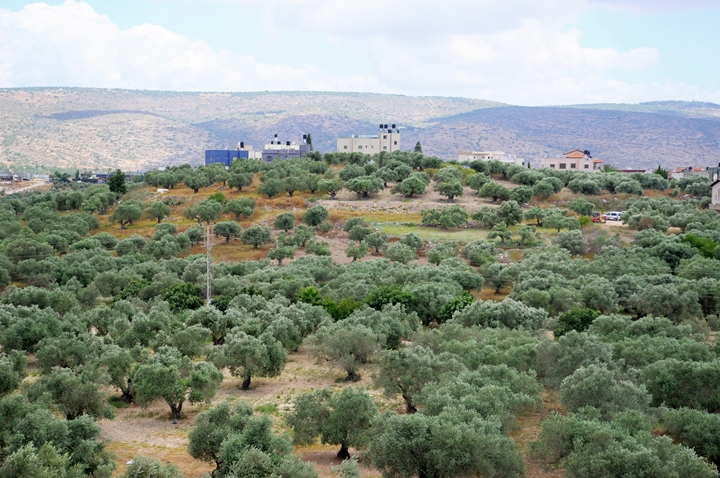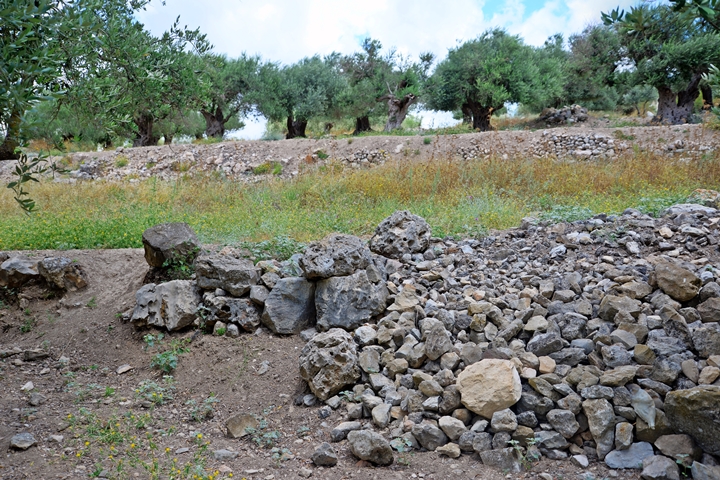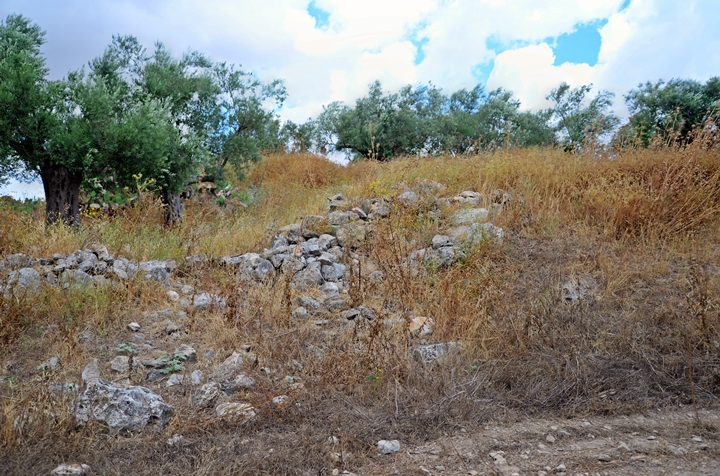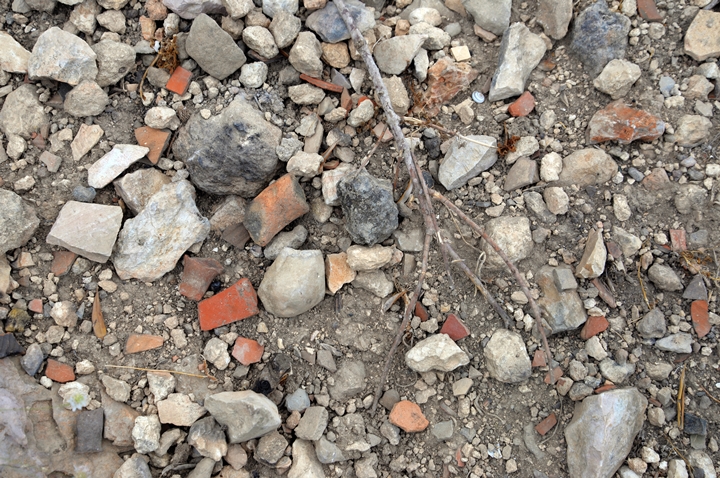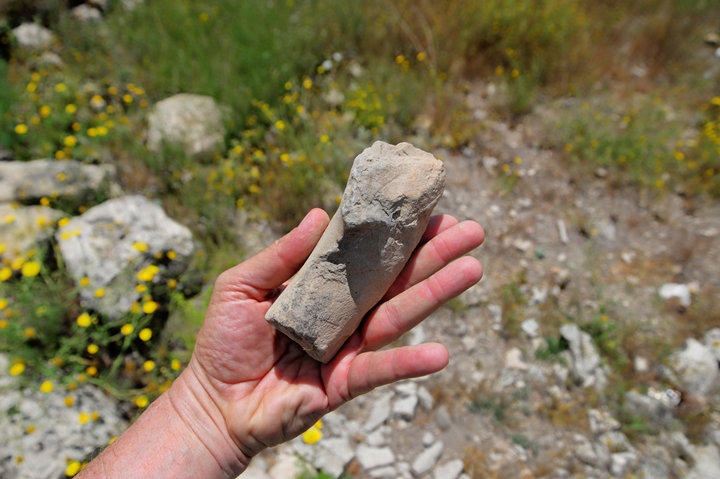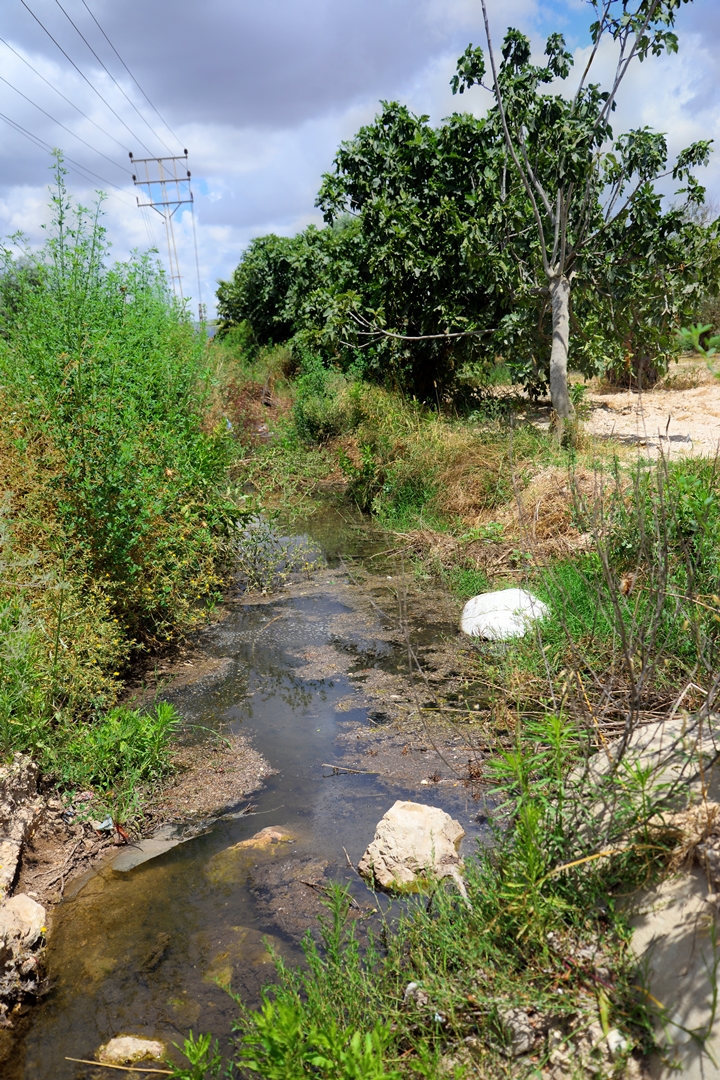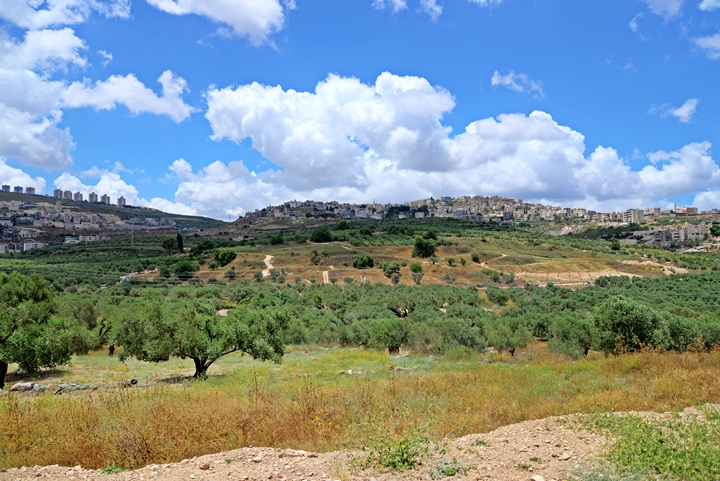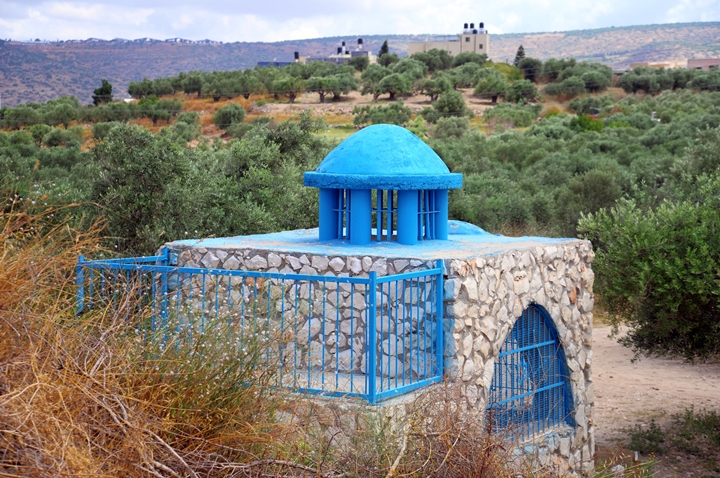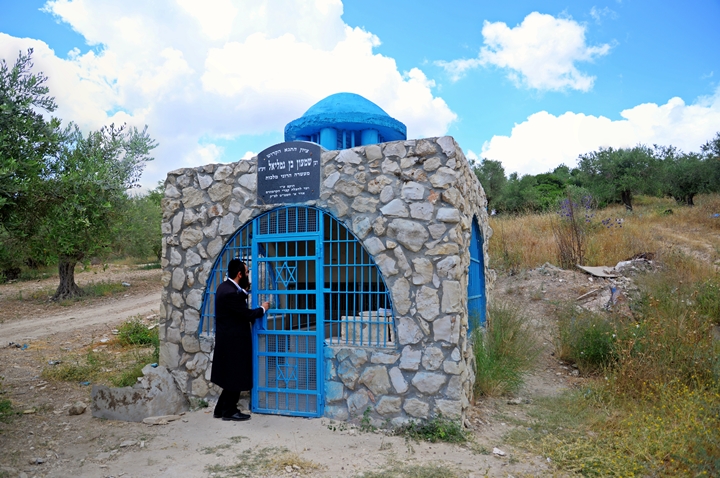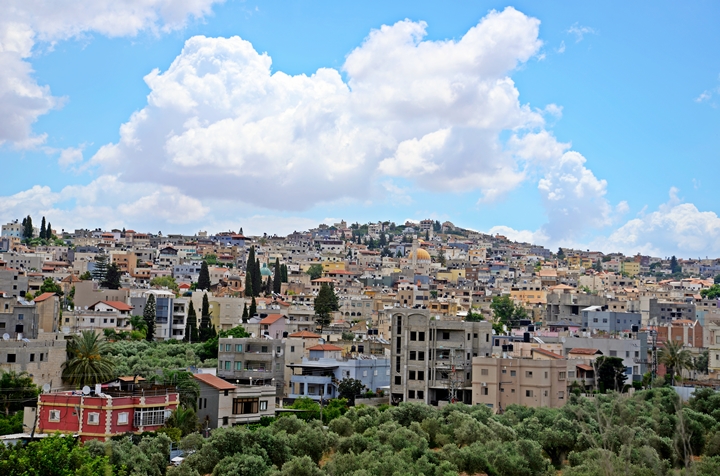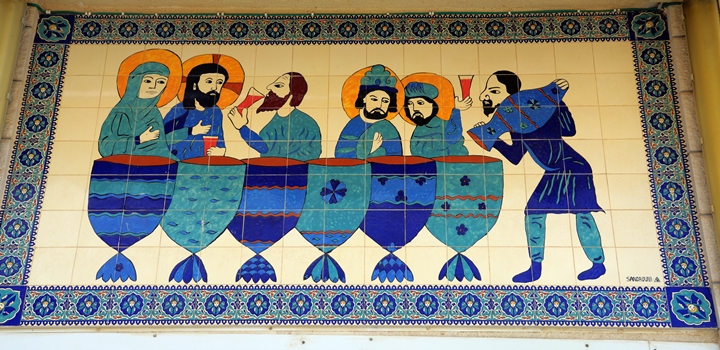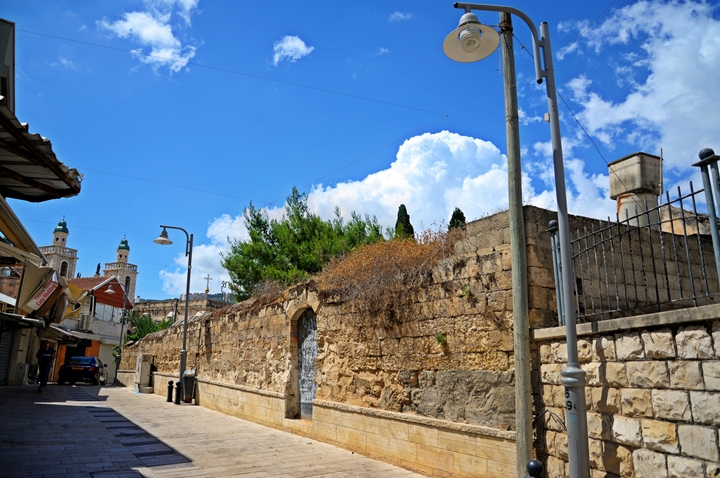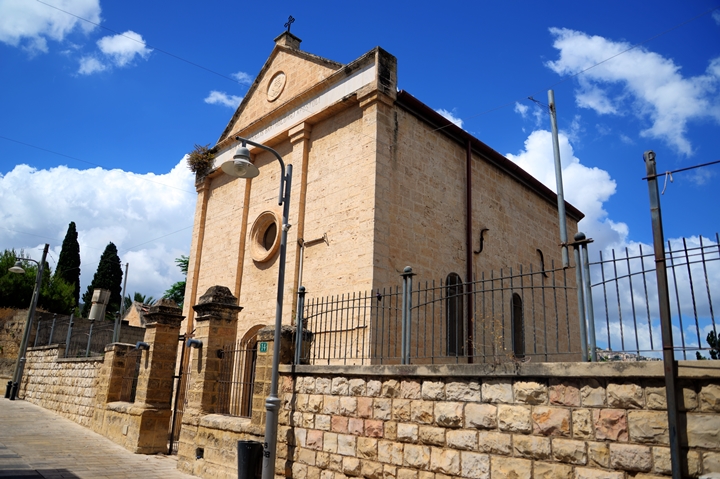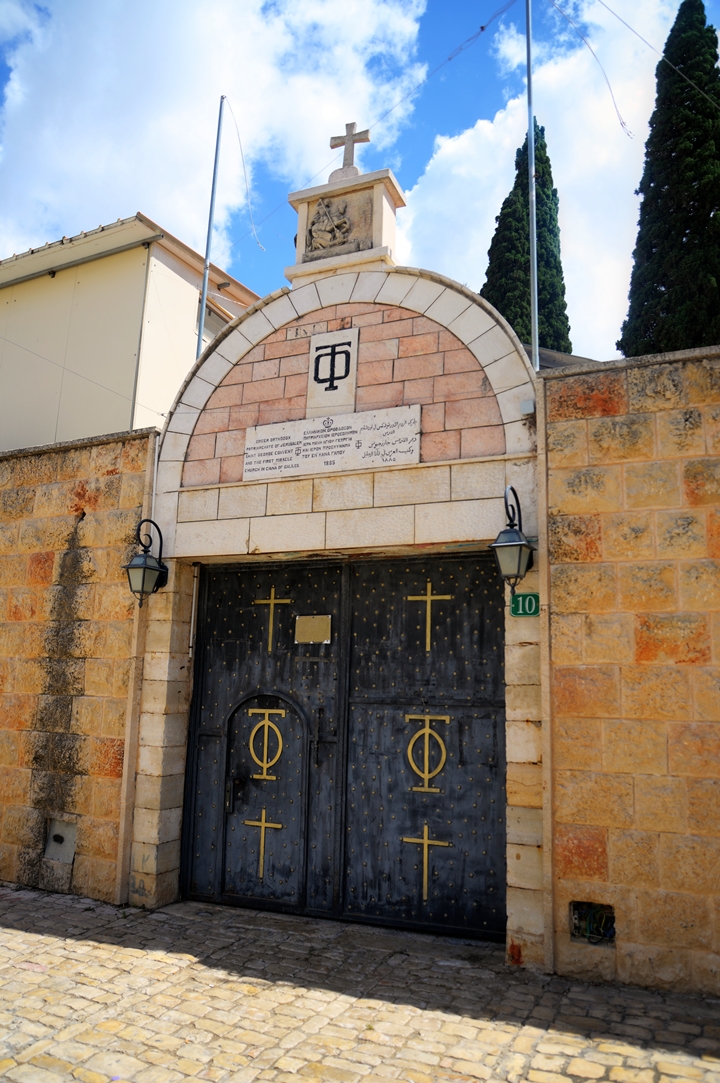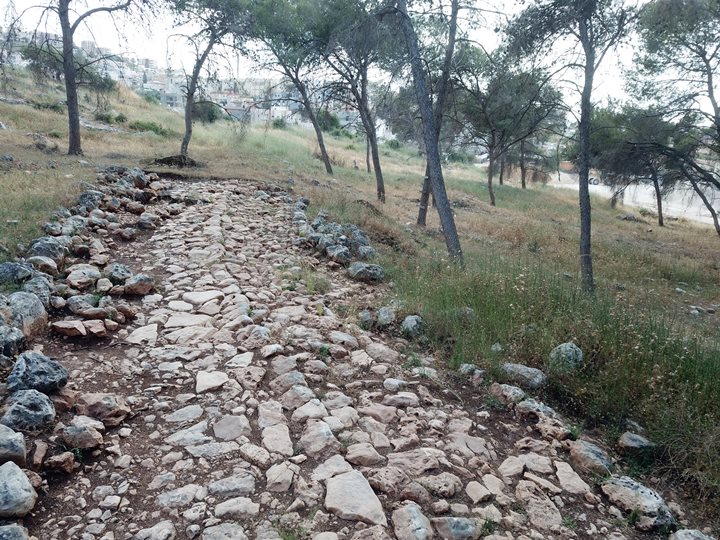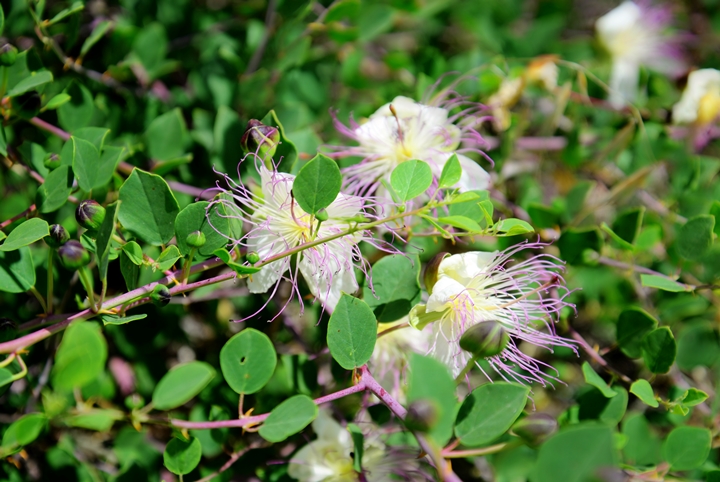Karm er-Ras is possible location of Jesus’s first miracle in Cana of Galilee- turning water to wine. The site is located near the traditional place in Kafr Kanna.
Home > Sites > Lower Galilee> Karm er-Ras and Kfar Kanna
Contents:
Background
Location
History
Identification
Photos
* Aerial Views
* Ground Views
* Simeon Ben Gamliel
* Kafr Kanna
* Roman Road
* Nature
Biblical References
Links
Historical Refs
Misc
Background:
Karm er-Ras is an Iron Age, Hellenistic and Roman/Byzantine period settlement west of Kfar Kanna. It is a candidate for the site of Jesus’s first miracle in Cana of Galilee, turning water to wine in a wedding. The site is located near the traditional place in Kafr Kanna. While Kafr Kanna has no archaeological remains from Jesus times, this site was once a Jewish village during the early Roman period and has a higher likelihood of being the site of the wedding. It was destroyed during the great revolt against the Romans.
Are these indeed the ruins of the ancient village of Cana of the Galilee, the site of Jesus’s first miracle – turning the water to wine?
John 2: 11: “This beginning of miracles did Jesus in Cana of Galilee and manifested his glory”.
Location and Aerial map:
The hill, where the site is buried, is covered by olive trees, giving its Arabic name – “the head of the vineyard”. An aerial map below shows the hill, indicating the major points of interest and its topography. The center of Karm er-Ras is indicated as a yellow square.
The area of the ancient village extended around the summit. Modern residential houses were built on the north and east side. The estimated boundaries of the village are marked as a yellow circle.
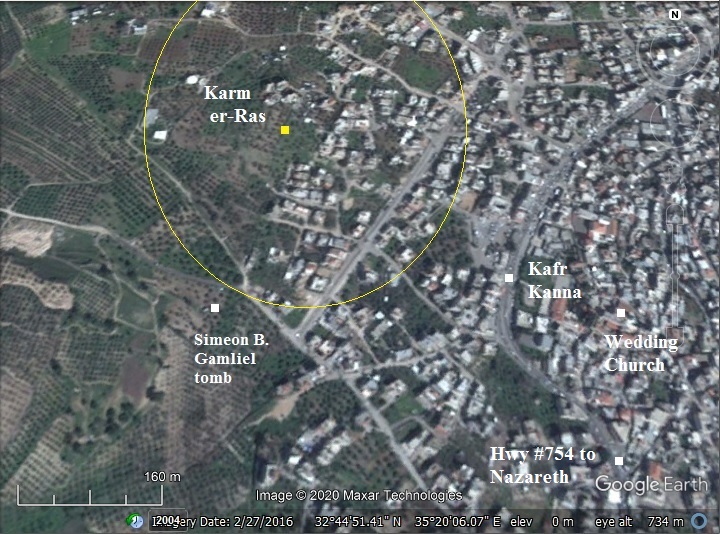
The site is 3KM east of Sepphoris – the capitol city of the Galilee during the Roman period. It is 7km northeast from Nazareth.
History:
According to the excavation areas opened on the east and north side of the hill, settlement periods included Iron Age, Hellenistic and Roman/Byzantine periods.
- Modern period
Dozens of mini-excavations, headed by Y. Alexandre, were conducted over the years during the constructions of the modern residential houses. They unearthed evidence of the Great revolt against the Romans, as well as Hellenistic thru Byzantine periods.
Identification:
The archaeologists suggested that this is the real site of Cana – the place of the first miracle of Jesus, turning water into wine during a wedding. The traditional place of the miracle is shown today in Churches street in nearby Kefar Kanna, but there were no Early Roman period findings in that area, while it is more likely to have occurred in Karm er-Ras. Therefore, the findings present an important discovery.
An alternative location of the first miracle site is in Khirbet Cana in the Netufa valley.
Photos:
(a) Aerial Views
This drone view is from the west. The center of the ancient village was located on this hill, and covered a large area around it. In the background is the modern town of Kfar Kanna. Its western neighborhood covers the north and east sections of the ruins.
The next view is from the south side of the hill, which is covered by olive trees. The ruins are scattered under the ground level, with few visible architectural elements visible above the surface except for some walls.
A view of the eastern side of the hill is next. The archaeological excavations were limited to small sections during the construction of the residential houses. It is unfortunate that these houses were built on this important site, but the owners had building permits before the importance of the site was recognized by the authorities.
Another view from the south side is next.
In the background, beyond a wide valley of Yiftachel stream, are the hills of Tur’an. The route of the main Roman road, including the modern highway #77, passes along the valley. This route connects the coast (west) to Tiberias (east) in the Sea of Galilee.
A stream passes along the south side of the hill, here on the left side of this view towards the west. This was also the possible route of the Roman road connecting the village of Karm er-Ras to the main Roman road connecting Tiberias to Sepphoris.
On the far background is Zippori Business and Industrial park, one of the largest industrial zones in Israel, covering an area of approximately 3,000 acres. The park is home to more than 150 factories and businesses in a variety of industries, including food and beverage production, metalworking, plastics, and more. The industrial park was established in the 1960s as part of a government effort to promote economic development and create jobs in the region. Today, it is one of the most important industrial zones in Israel, and it plays a key role in the country’s economy.
![]() The following video shows a view of the site and its surroundings, as captured by the drone. It starts over the south side, then turns to the west.
The following video shows a view of the site and its surroundings, as captured by the drone. It starts over the south side, then turns to the west.
(b) The Hill
This photo is a ground level view of the center of the site – a hill covered by olive trees.
The hill was not yet excavated, and only few walls and fragments of ceramics are visible on the hillside.
Another view of the hillside:
Ceramics fragment are scattered all around.
On the north side of the hill is a stream (which could very well be a runoff sewage water from the looks of it). Nevertheless, this is Kafr Kanna stream, which flows to the north west down to Yiftachel stream. In ancient times it was one of the sources of water supply for the village. The source of the waters is from the hills of ‘Ain Mahil and Meshhed, where a dozen springs are located.
(c) Simeon Ben Gamliel
On the south west side of Karm er Ras is the village of Meshhed, where a 14th century tradition holds that the prophet Jonah is buried. Its houses are seen here on the top of the hill. In its center is Tel Gath-Hefer – the prophet’s home according to the tradition.
Closer to Karm er-Ras is the tomb of Simeon Ben-Gamliel (he lived in years 10BC – 70 AD). Simeon was a Tanna sage, and as president of the Sanhedrin he was a religious leader of the Jewish people during the great revolt.
Simeon was one of the 10 martyrs according to Jewish liturgy, beheaded along with the high priest Rabbi Ishmael ben-Elishat.
Simeon ben Gamliel (also spelled Shimon ben Gamliel) was a Jewish scholar who lived in the first and second centuries CE. He was a prominent member of the Sanhedrin, the Jewish court of law and one of the most important institutions in Jewish life at the time. Simeon ben Gamliel was the third in a line of prominent rabbis with the same name, and he served as the president of the Sanhedrin from 50-70 CE.
Simeon ben Gamliel was known for his leadership, scholarship, and piety, and he played an important role in shaping Jewish law and tradition during a tumultuous period in Jewish history. He was a contemporary of some of the most important figures in Jewish history, including Rabbi Akiva, Yochanan ben Zakkai, and the famous general and historian Josephus. Some of Simeon ben Gamliel’s most famous teachings and sayings are recorded in the Talmud, the central text of Jewish law and tradition. He is especially known for his teachings on the importance of education and the study of Torah, which he saw as the foundation of Jewish life and the key to the survival of the Jewish people.
Simeon was the son of Rabbi Gamaliel the Elder, and grand-grandson of Hillel the Elder. Gamaliel the Elder was, like his son, the president of the Great Sanhedrin in Jerusalem, and a leading Pharisee scholar. Pharisees are noted for their scholarship and fairness, and follow the Biblical golden rule (Leviticus 19 18): “thou shalt love thy neighbor as thyself”. Rabbi Gamaliel was a indeed moderate person and favored the early Christians. The Acts of Apostles tell us that Gamaliel the Elder was also the teacher of Paul the Apostle (Saul of Tarsus, 5 BC – 67 AD) – one of the most influential early Christian missionaries. (Acts 22:3): “I am verily a man which am a Jew, born in Tarsus, a city in Cilicia, yet brought up in this city at the feet of Gamaliel…”.
The tomb is attended daily by many Jewish visitors who come from all parts of the country to pray at the tomb of the distinguished spiritual leader.
(d) Kafr Kanna
The nearby Arab town of Kafr Kanna is located on the east side of Karm er-Ras. Its western neighborhoods ‘swallowed’ some of the antiquities of the ancient site.
The town boasts to be the site of the first miracle of Jesus. Here is an illustration of the wedding on top of one of the shops.
In its center of the town is the Churches street. Along this strip are a number of Christian institutes. In the far background below is the Franciscan Cana Wedding church with its double bell tower, built in 1881 .
Next – the Franciscan order’s St. Bartholomew the Apostle (Latin: Ecclesia Sancti Bartholomei Apostoli) Catholic Church, founded in 1885:
Finally, the Greek Orthodox Church:
(e) Roman Road
A paved Roman road was recently unearthed in a forest east of Kafr Kanna. The excavated section extends to 200m. It has a unique plan of 2 lanes, with a line of stones dividing both lanes. Each lane is 2.4m (8 ft) wide.
The road is directed east towards Tiberias. It allowed a direct path from Sepphoris (Roman Diocaesarea) along the hill side, thus bypassing the muddy Yiftachel valley during the winter. At Horvat Mishkana (Golani junction) the road joined Roman roads directed to the North and South.
The IAA excavations are conducted in preparation to a planned eastern expansion of Kafr Kanna, and we hope that this unique road is further explored and preserved. (Also viewed in YouTube)
(f) Nature
Among the wild flowers observed during the hike was the thorn named common Caper (Capparis Sicula; Hebrew – Zalaph Sicily). Its name appears in Nehemiah 3:30 ( “Hanun the sixth son of Zalaph”), and in the Talmud (Sabbath 30 2), where Rabban Gamliel uses the Caper as an example for renewal.
Biblical References:
Cana of Galilee is mentioned only in the forth Gospel – John. According to Hunter [1968] the Gospel of John is usually accurate with specific locations.
(a) John, Chapter 2: 1-11:
The first miracle at Cana of Galilee:
“And the third day, there was a marriage in Cana of Galilee: and the mother of Jesus was there. And Jesus also was invited, and his disciples, to the marriage. And the wine failing, the mother of Jesus saith to him: They have no wine.
And Jesus saith to her: Woman, what is that to me and to thee? My hour is not yet come. His mother saith to the waiters: Whatsoever he shall say to you, do ye. Now there were set there six waterpots of stone, according to the manner of the purifying of the Jews, containing two or three measures apiece. Jesus saith to them: Fill the waterpots with water. And they filled them up to the brim. And Jesus saith to them: Draw out now and carry to the chief steward of the feast. And they carried it. And when the chief steward had tasted the water made wine and knew not whence it was, but the waiters knew who had drawn the water: the chief steward calleth the bridegroom, And saith to him: Every man at first setteth forth good wine, and when men have well drunk, then that which is worse. But thou hast kept the good wine until now. This beginning of miracles did Jesus in Cana of Galilee and manifested his glory. And his disciples believed in him”.
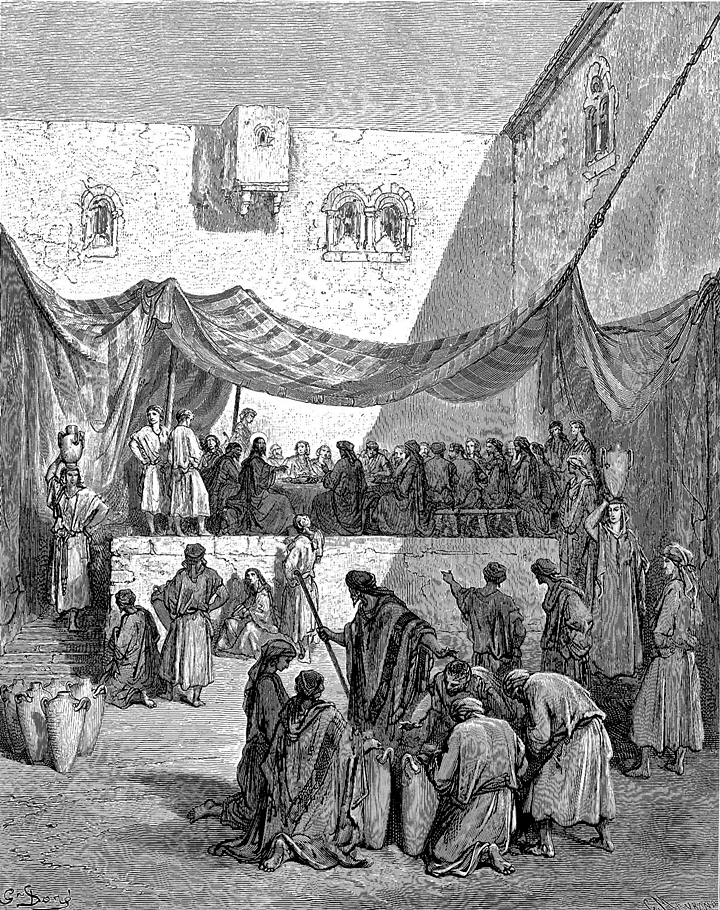
Jesus at the marriage in Cana – Drawing by Gustav Dore (French artist, 1832-1883)
(b) John, Chapter 4: 46-54:
This is the 2nd miracle at Cana:
“So Jesus came again into Cana of Galilee, where he made the water wine. And there was a certain nobleman, whose son was sick at Capernaum. When he heard that Jesus was come out of Judaea into Galilee, he went unto him, and besought him that he would come down, and heal his son: for he was at the point of death. Then said Jesus unto him, Except ye see signs and wonders, ye will not believe. The nobleman saith unto him, Sir, come down ere my child die. Jesus saith unto him, Go thy way; thy son liveth. And the man believed the word that Jesus had spoken unto him, and he went his way. And as he was now going down, his servants met him, and told him, saying, Thy son liveth.
Then enquired he of them the hour when he began to amend. And they said unto him, Yesterday at the seventh hour the fever left him. So the father knew that it was at the same hour, in the which Jesus said unto him, Thy son liveth: and himself believed, and his whole house. This is again the second miracle that Jesus did, when he was come out of Judaea into Galilee”.
(c) John, Chapter 21: 1-2:
Cana is also mentioned as the home town of Nathanael, one of his disciples resurrection:
“After these things Jesus shewed himself again to the disciples at the sea of Tiberias; and on this wise shewed he himself. There were together Simon Peter, and Thomas called Didymus, and Nathanael of Cana in Galilee, and the sons of Zebedee, and two other of his disciples”.
(d) 1 Chronicles 24: 12,19:
After the destruction of Jerusalem (70AD), the Cohen family of Eliashib came to Canna, according to old Jewish texts. The Eliashib family is one of the 24 families that served in the Temple before it was destroyed:
“The eleventh to Eliashib… These were the orderings of them in their service to come into the house of the LORD, according to their manner, under Aaron their father, as the LORD God of Israel had commanded him”.
References:
- Hunter [1968, Westminster press] – “According to John”. A new look at the forth Gospel.
- Laurence Oliphant “Haifa, or Life in Modern Palestine” [1884]
His article was published on May 1 1883 in the New York “Sun”, with the title ” “Holy sites” in the Galilee”, where he tells his readers about his trip to Sepphoris. He also talks about how the “other Kefar Cana”, several miles north of Nazareth, whose 120 poverty-stricken citizens established a “Holy site” status in order to capitalize on the pilgrimage, converting from Greek-Orthodox to Catholic as part of the “package deal”. He doubted that it was the real site and points to Khirbet Cana (“Kana El-Jalil”) as the true Cana.
Links:
Archeological References:
- Excavation reports:
Area Q Area M Area E Area S Area U
Area N Area T Area K Area L Area P Area V
Area AA final report Area H,J Area C,D Area AB,AC final report
Area F,G Area A,B
- Alexandre, Y. (2008). The archaeological evidence of the Great Revolt at Karm er-Ras (Kfar Kanna) in the Lower Galilee.
Internal Links:
- Khirbet Cana – in the Netufa valley, an alternative candidate for the Cana of Jesus
- Jesus footsteps – 100 events in 1000 last days
- Jesus travel maps
- Wild flowers of the Holy Land
- Roman Roads
BibleWalks.com – exploring the sites of the Bible
Tel Adami<<<— Previous lower Galilee site—<<< All Sites>>> —next site—>>>
This page was last updated on May 20, 2023 (add Roman Road)
Sponsored links:
